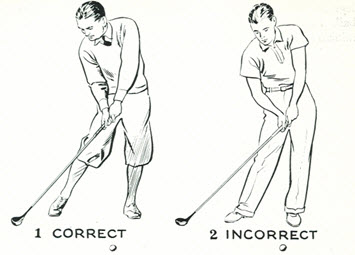Player’s Legs, Midsection Exerting Sudden Wrench to Put Final Punch into Blow . . . Right Arm at This Stage Assists in Whipping Club Through
The phase of the golf stroke selected for illustration, see Figure 11, was a point a little less than halfway through the downstroke when the hands had reached a level a little above the waist. It was quite apparent that, up to this point, only one source of power, the hip-turn, had been drawn upon to any great extent.
The bend of the wrists, measured by the angle between the left arm and the shaft of the club, had opened very slightly, and the right arm was still bent, with its elbow still nestling close to the side. Now we shall study a slightly later position.
Refer to illustration, Figure 11, and compare it with that with Figure 12. It will be noticed that the body-turn has progressed very little in the interval. At the former stage, almost everything possible had been gotten from the unwinding.
But here, in the climactic phase of the stroke, we see the hips, legs and back being used in a different way. Observe that the left leg has begun to straighten, that the left knee is being thrown straight back, and that the left shoulder is being thrust upward.
This movement, being quick and forcible, exerts a powerful pull up the taut left arm and greatly increases the speed with which the wrist-angle is “split” open.
The sensation is of a sudden wrench in the player’s legs and mid-section as he puts in the final punch before impact.
No Roll to Right Arm
In this picture also, we see very clearly what the right arm should be doing. Having taken little part in the swing up to now, and having dropped in close to a position whence it can deliver its force in the right direction, it has now begun to assist in whipping the club through. But it displays no desire to roll or “climb” over the left. Both hands direct the blow outward towards the objective.

Figure 12
The companion illustration, Figure 12, above, is intended to be a representation of the indecisive stroke so often seen among ineffective players. To a casual observer it is likely to appear to be moderately good. But a practiced eye will not like the sag in the legs and hips nor the head and shoulders turning away from the ball. I always have the feeling that the possessor of such a swing is thinking more of appearing easy and graceful than of hitting the ball.
Avoid Tightening Left Side at Impact
Restricts Free Swing Action . . . Left Hip Should Be Out of Way to Let Left Arm Swing Through
At last, we come to the action at impact, when we get the verdict which tells us, in no uncertain terms, how well and how closely we have stuck to the fundamentals of good form through-out the swing. Occasionally, to be sure, by offsetting one mistake by another, or by a last-minute correction, a surprisingly good shot may result from a swing that is not all that could be desired. But this smacks too much of the blind hog and the acorn. The consistent player—and he is the one who wins can take no such chances. He can be consistent only by being sound from start to finish.